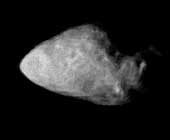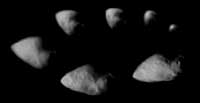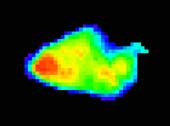
NASA's Stardust spacecraft successfully completed a close flyby of asteroid Annefrank on November 2, 2002 as an opportunity for a full dress rehearsal of procedures the spacecraft will use during its January 2, 2004, encounter with it primary science target, comet Wild 2.
Annefrank is about 4 kilometers (2.5 miles) across. Stardust passed within about 3,300 kilometers (2,050 miles) of the asteroid at 04:50 today, Universal Time (8:50 p.m. November 1, Pacific Standard Time). Radio signals confirming the basic health of the spacecraft after the flyby were received about 30 minutes later via an antenna at the Canberra, Australia, complex of NASA's Deep Space Network, said Thomas Duxbury, project manager for Stardust at NASA's Jet Propulsion Laboratory, Pasadena, Calif.
Stardust visually tracked the asteroid for 30 minutes as it flew by at a relative speed of about 7 kilometers (4 miles) per second, a major goal of this test opportunity. Although no dust was anticipated near the asteroid, the spacecraft's dust instruments were in use as they will be at Wild 2: the dust collector was open and the dust counter from the University of Chicago and dust mass spectrometer from Germany were turned on.
Stardust will bring samples of comet dust back to Earth in 2006 to help answer fundamental questions about the origins of the solar system.
 Best Super-resolved Image of Asteroid Annefrank
Best Super-resolved Image of Asteroid Annefrank
This is the best super-resolved image of asteroid
Annefrank. It was created by using super-resolution techniques
with more than 40 images taken by Stardust's during its
flyby of the asteroid in 2002.
Stardust flew within about 3,300 kilometers (2,050 miles) of the
asteroid as a rehearsal for the spacecraft's encounter with its
primary target, comet Wild 2, in January 2004. The camera's
resolution was sufficient to show that Annefrank is about 8
kilometers (5 miles) in length, twice the predicted size from
Earth-based observations. The surface reflects about 0.1 to 0.2
percent of sunlight, slightly less than anticipated. A few craters
that are hundreds of meters across can be seen. The straight edge
in the right side of the image may be an artifact of processing.
(Copyright 2005 Ted Stryk)
 Super-resolved Flyby Images of Asteroid Annefrank
Super-resolved Flyby Images of Asteroid Annefrank
This image shows a set of super-resolution views of asteroid
Annefrank from Stardust's flyby. These are the best super-resolved
images that have been produced.
(Copyright 2005 Ted Stryk)
![]() Super-resolved Flyby Images of Asteroid Annefrank
Super-resolved Flyby Images of Asteroid Annefrank
This image shows a set of super-resolution views of asteroid
Annefrank from Stardust's flyby. These are the best super-resolved
images that have been produced.
(Copyright 2005 Ted Stryk)
 Stardust Image of Asteroid Annefrank
Stardust Image of Asteroid Annefrank
Asteroid Annefrank is seen as irregularly shaped, cratered body in an
image taken by NASA's Stardust spacecraft during a November
2 flyby of the asteroid.
Stardust flew within about 3,300 kilometers (2,050 miles) of the
asteroid. The camera's resolution was sufficient to show that Annefrank is about 8
kilometers (5 miles) in length, twice the predicted size from
Earth-based observations. The surface reflects about 0.1 to 0.2
percent of sunlight, slightly less than anticipated. A few craters
that are hundreds of meters across can be seen.
(Courtesy NASA/JPL)
 Asteroid Annefrank Near Closest Approach
Asteroid Annefrank Near Closest Approach
False colors emphasize the variations in surface brightness on
asteroid Annefrank. The variations in
surface brightness result from different angles of solar
illumination, as well as from intrinsic variations in the
surface.
(Courtesy NASA/JPL)

 Asteroids
Asteroids